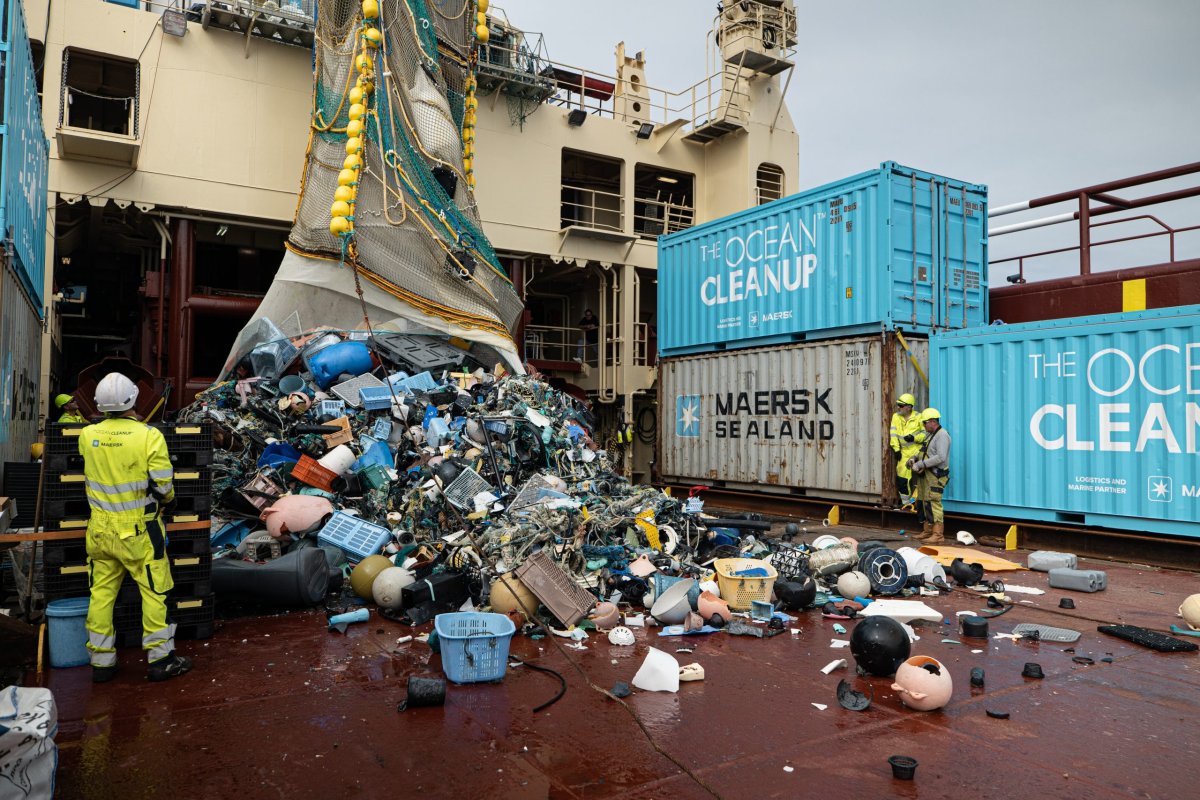Environmental organization The Ocean Cleanup has denied accusations that it staged a massive plastic removal operation after social media users claimed the debris looked too clean.
The Ocean Cleanup shared footage of a net pulling up 3,810kg (8,400lb) of plastic it had removed from a patch of ocean known as the Great Pacific Garbage Patch on Twitter. The video can be viewed here.
Here's the footage of another 3810kg catch from the Great Pacific Garbage Patch on February 5th. Next extraction is scheduled today. ✔️ pic.twitter.com/DSx0kxPWEF
— The Ocean Cleanup (@TheOceanCleanup) February 14, 2022
The Great Pacific Garbage patch is an area between Hawaii and California where a large amount of litter, fishing gear, and other marine debris has collected. Large amounts of debris accumulates here because it is surrounded by the North Pacific Subtropical Gyre, which is a system of swirling ocean currents.
Plastic is brought to the garbage patch by the currents, however settles when it gets to the center of the gyre, which is a calm and stable part of water. It then becomes trapped in the middle.
A 2018 study estimated there was roughly 79,000 tons of plastic in the patch.
The Ocean Cleanup was founded in 2013 by Dutch inventor Boyan Slat. It has the goal of removing 90 percent of plastic from the Great Pacific Garbage Patch by 2040, with plans to scale-up its current operations over the coming years.
It uses trawlers to catch the plastic, attached to the back of its ships. The organization has established a system using large trawlers to maximise the amount of plastic caught. Bycatch, the accidental capture of sea life such as fish, is often an inevitable part of fishing and plastic clean up operations, as the modern nets and fishing gear are efficient at catching everything in their path.
The Ocean Cleanup claims it have developed nets and technology that avoid the amount of bycatch it their nets and fish can easily swim in and out.
However, the latest footage has raised suspicions among experts, with many claiming it is staged.
Experts wondered why the hauled up plastic looked so clean, despite some having been in the ocean for decades. Others raised concerns that there appears to be no bio-fuelling on the plastic, which refers to the growth of organisms such as barnacles and algae.
This is what years-old trash looks like in the middle of the Pacific. Or, at least *some* of it should look like this. The Ocean Cleanup has some explaining to do. https://t.co/EM0eqUb8yP
— Clark Richards, PhD (@ClarkGRichards) February 15, 2022
For those of you raising an eyebrow at the suspiciously clean plastic being pulled from the ocean by the Cleanup people, compare 👇 https://t.co/HYX7U9M7CZ
— Katie Matthews (@katie_at_sea) February 15, 2022
Trevor Branch, associate professor at the School of Aquatic and Fishery Sciences at the University of Washington, initially raised his suspicions in a tweet, claiming it was "odd."
He told Newsweek: "The plastic they picked up, most of which they say is 10 to 30 years old, is so clean and free of the organisms that usually grow very quickly on anything in the ocean ... although I am not an expert in biofouling, others had similar questions."
Similarly, David Shiffman, marine conservation biologist at Arizona State University, told Newsweek he thought the footage "raised eyebrows."
"The imagery they showed is just not at all what it would look like if one were to truly drag a big net through the ocean and scoop up plastic that had been floating there for years," he said. "It's too brightly colored, nothing is growing on it, and they didn't catch anything but plastic."

A spokesperson for The Ocean Cleanup, told Newsweek that the clean plastic can be explained through "various factors."
The Great Pacific Garbage Patch is what is known as 'oligotrophic,' they said, which means it is very low in nutrients. "There's a reason these subtropical gyres—where we are currently busy catching plastic—are also called the 'deserts of the sea.' Nutrients typically come from rivers or from the upwelling of deeper waters," they said.
"However, these gyres are far away from land and dominated by downwelling of water, not upwelling. This means that very few nutrients reach these gyres, resulting in less algae growth and plastic that remains relatively clean in appearance."
Biofouling typically only occurs on parts of objects that are completely submerged underwater, they said. However, if the plastic sticks out of the water, UV radiation will stop any biofouling.
"Good examples of this are buoys or floats'', the spokesperson said. "Underwater, they are typically covered in barnacles, while on top, they are generally deprived of marine life. Some of the plastics that we catch have additives added to them. This protects them from UV light, "thus 'preserving' their colors", and biofouling organisms (especially for objects used by fisheries)."
Boyan Slat, CEO of The Ocean Clean Up, also addressed the lack of biofouling on Twitter. He also said it was down to oligotrophic waters and UV light.
Why no biofouling? A combination of an oligotrophic waters (=little nutrients) and UV killing the fouling. When we do see fouling it’s in parts of objects that are permanently in the shade, away from UV rays.https://t.co/UWhQeeHmyj pic.twitter.com/zx3wJSBfc5
— Boyan Slat (@BoyanSlat) February 15, 2022
Branch said that the explanation that gyre is oligotrophic and low in nutrients is true.
"However others commenting on the footage report heavy biofouling in similar areas," he said. "Their explanation that UV light stops things growing on plastic is unlikely. UV light is just sunshine, and seaweed needs sunlight to grow."
David Shiffman's job title has been updated.
Correction 02/17/22 8.41 a.m. ET: The spelling of California has been corrected.
Uncommon Knowledge
Newsweek is committed to challenging conventional wisdom and finding connections in the search for common ground.
Newsweek is committed to challenging conventional wisdom and finding connections in the search for common ground.
About the writer
Robyn White is a Newsweek Nature Reporter based in London, UK. Her focus is reporting on wildlife, science and the ... Read more
To read how Newsweek uses AI as a newsroom tool, Click here.








